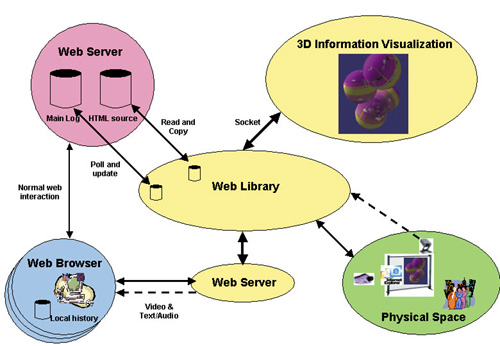
|
|
ERCIM News No.46, July 2001 [contents]
|
by Emmanuel Frécon, Anneli Avatare and Adrian Bullock
The WebPR application promotes awareness and cooperation between physical and digital users by embedding digital information in public spaces and making it accessible to people who are present in those spaces.
The ICE-lab at SICS is currently developing a range of illustrative electronic landscapes that combine the physical and the digital in order to realize new forms of interactive experiences. One of these is the WebPR application, an application that aims to bridge the gap between the digital world of the Web and the physical world of real life organisations, activities and people. WebPR builds on the work of WebPath (see ‘WebPath—a 3-D Browsing History Visualisation’ by Emmanuel Frécon in ERCIM News 41) and visualises and personifies Web traffic for the Web server of an organisation at some central point, eg a reception area. Our aim is that WebPR will bring back an embryo of collaboration between digital and physical inhabitants and a more human-oriented vision to the digital age of Web servers.
We assume that in the future there will be universal access to online information and a universal digital information society: the future Internet environment. One of the most ubiquitous electronic landscapes in use today is the World Wide Web. One vision of the future sees society living in a totally digital environment, ‘jacking in’ to alternate realities as in the film The Matrix and the writings of Gibson and Stephenson, for example. However, we suggest that even given the sophisticated digital worlds of the future, there will always be the need for the physical, both physical contact and physical settings, and that meetings and visits will long be an inherent part of a business. We want to be able to offer a channel through which the digital and the physical will be able to exchange enough information to keep contact and bring back a human-oriented vision to the digital age of Web servers.
In particular we focus on Web servers as our digital environments and reception areas and foyers as our physical environments. With the popularity of the Web increasing exponentially, Web presence has become more and more important and all organisation types are concerned, from small and medium businesses, through big conglomerates, to government agencies. The Internet is here to stay and the amount of information that can be found on Web servers increases at a pace similar to the increase of new connections. For organisations, more people connected means that the information presented has more potential and will reach out to the masses. For business-oriented organisations, this means an increasing number of customers. For public organisations, this means the possibility to better communicate with the citizens, inform them on the latest decisions and let them know what taxes are used for. In short, one of the main reasons for having an attractive Web server is to improve public relations in general.
However, the exponential popularity increase of the Web introduces an awareness gap between virtual visitors and employees. The day-to-day contact that used to be the building block of our working habits is disappearing in favour of anonymity. WebPR was developed in order to bridge this gap. Employees and visitors at the physical setting of an organisation will use WebPR to get a sense of the amount of (virtual) customers and connected persons, together with their interests and actions. This will be achieved through visualising and personifying Web traffic for the Web server of the organisation at some central places of its physical setting, eg foyers, receptions, etc.
At the heart of WebPR is the Web Library, a collection of programs written in Tcl/Tk, which govern and control all the interactions and interplay that takes place in the installation (see Figure 1). The other main component of the application is the information visualisation.
 |
| Figure 1: The WebPR architecture. |
Figure 2 shows the WebPR application. It consists of a visualisation window, a web browser, and an interface to the Web Library. The main aim of the visualisation is to be sufficiently interesting and engaging to the passer by. It supports some control from occasional employees or visitors and in the future will offer an automatic mode (like a screensaver). It has to be appealing enough to be run discontinuously every day. We believe that the quality of the visualisation lies not only in the aesthetic of its appearance but also in the amount of information that it synthesises.
 |
| Figure 2: The WebPR application. |
Initial internal trials have been made with the demonstrator, with mixed success, and we are currently reviewing the visualisation approach and method.
Links:
http://www.sics.se/ice/projects/infocity
Please contact:
Emmanuel Frécon — SICS
Tel: +46 8 633 15 34
E-mail: emmanuel@sics.se